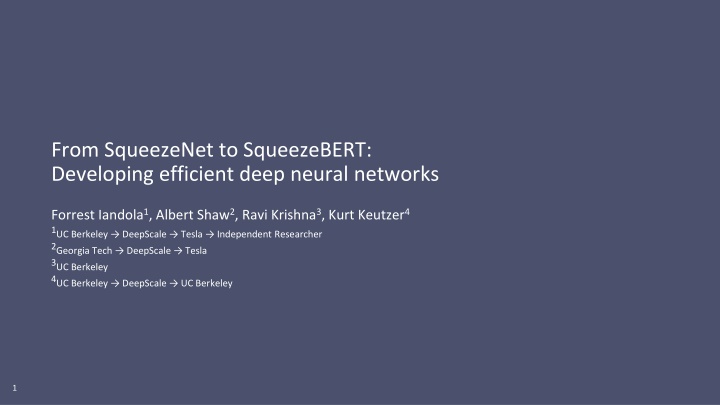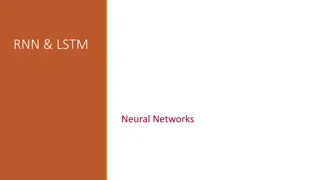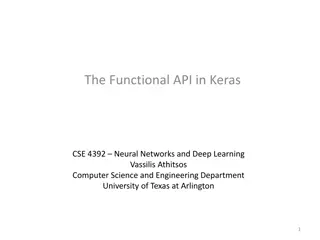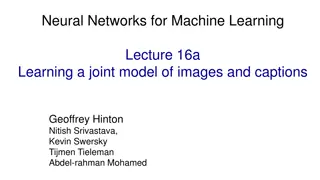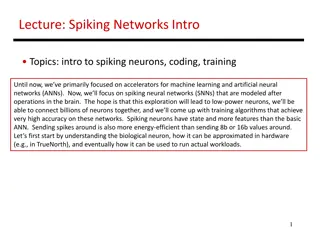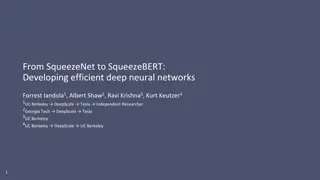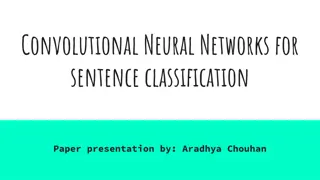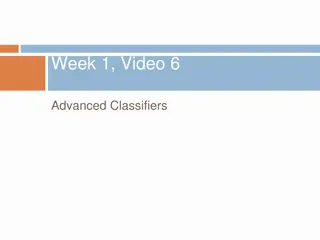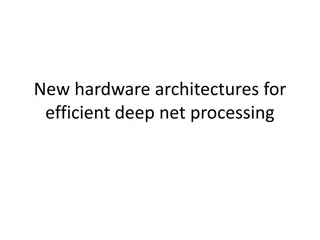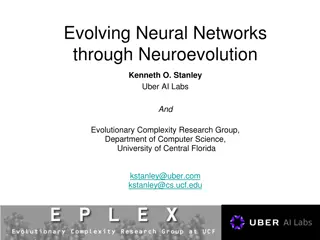Efficient Deep Neural Networks: From SqueezeNet to SqueezeBERT
Developing efficient deep neural networks has seen significant progress in the past few years, demonstrated by advancements like SqueezeNet and SqueezeBERT. This article delves into the insights gained, the intersection of Computer Vision and Natural Language Processing, key tasks in computer vision, progress in image classification, and advancements in semantic segmentation. The content highlights key datasets, notable works, and the factors driving these improvements.
Download Presentation

Please find below an Image/Link to download the presentation.
The content on the website is provided AS IS for your information and personal use only. It may not be sold, licensed, or shared on other websites without obtaining consent from the author.If you encounter any issues during the download, it is possible that the publisher has removed the file from their server.
You are allowed to download the files provided on this website for personal or commercial use, subject to the condition that they are used lawfully. All files are the property of their respective owners.
The content on the website is provided AS IS for your information and personal use only. It may not be sold, licensed, or shared on other websites without obtaining consent from the author.
E N D
Presentation Transcript
From SqueezeNet to SqueezeBERT: Developing efficient deep neural networks Forrest Iandola1, Albert Shaw2, Ravi Krishna3, Kurt Keutzer4 1UC Berkeley DeepScale Tesla Independent Researcher 2Georgia Tech DeepScale Tesla 3UC Berkeley 4UC Berkeley DeepScale UC Berkeley 1
Overview Part 1: What have we learned from the last 5 years of progress in efficient neural networks for Computer Vision? Part 2: SqueezeBERT what can Computer Vision research teach Natural Language Processing research about efficient neural networks? 2
Key tasks in computer vision (abridged) Image Classification Object Detection Semantic Segmentation Slide credit: Kurt Keutzer 3
Progress in image classification Dataset: ImageNet validation set [1] Kaiming He, Xiangyu Zhang, Shaoqing Ren, Jian Sun. Deep Residual Learning for Image Recognition. arxiv:1512.03385 and CVPR 2016. [2] Forrest N. Iandola, Song Han, Matthew W. Moskewicz, Khalid Ashraf, William J. Dally, and Kurt Keutzer SqueezeNet: AlexNet-level accuracy with 50x fewer parameters and < 0.5MB model size. arXiv, 2016. [3] Hugo Touvron, Andrea Vedaldi, Matthijs Douze, Herv J gou. Fixing the train-test resolution discrepancy: FixEfficientNet. arXiv:2003.08237, 2020. 4
Progress in image classification Dataset: ImageNet validation set [1] Kaiming He, Xiangyu Zhang, Shaoqing Ren, Jian Sun. Deep Residual Learning for Image Recognition. arxiv:1512.03385 and CVPR 2016. [2] Forrest N. Iandola, Song Han, Matthew W. Moskewicz, Khalid Ashraf, William J. Dally, and Kurt Keutzer SqueezeNet: AlexNet-level accuracy with 50x fewer parameters and < 0.5MB model size. arXiv, 2016. [3] Hugo Touvron, Andrea Vedaldi, Matthijs Douze, Herv J gou. Fixing the train-test resolution discrepancy: FixEfficientNet. arXiv:2003.08237, 2020. 5
Progress in semantic segmentation Dataset: Cityscapes test set [1] Jonathan Long, Evan Shelhamer, Trevor Darrell. Fully Convolutional Networks for Semantic Segmentation. arXiv:1411.4038 and CVPR 2015. [2] Liang-Chieh Chen, Yukun Zhu, George Papandreou, Florian Schroff, Hartwig Adam. Encoder-Decoder with Atrous Separable Convolution for Semantic Image Segmentation. (DeepLabV3+ paper.) ECCV, 2018. [3] Albert Shaw, Daniel Hunter, Forrest Iandola, Sammy Sidhu. SqueezeNAS: Fast neural architecture search for faster semantic segmentation. arXiv:1908.01748 and ICCV Workshops, 2019. 6
What has enabled these improvements? (1/3) Grouped Convolutions cout= 8 cin= 8 (a) groups=1 cin= number of input channels cout= number of output channels [1] A. Krizhevsky, I. Sutskever, G. E. Hinton, ImageNet Classification with Deep Convolutional Neural Networks. NeurIPS, 2012. 8
What has enabled these improvements? (1/3) Grouped Convolutions cout= 8 cout= 8 cout= 8 cin= 8 cin= 8 cin= 8 (a) groups=1 (b) groups=4 (c) groups=4 with optimized storage cin= number of input channels cout= number of output channels [1] A. Krizhevsky, I. Sutskever, G. E. Hinton, ImageNet Classification with Deep Convolutional Neural Networks. NeurIPS, 2012. 9
What has enabled these improvements? (2/3) Dilated Convolutions Dilated 3x3 Convolution Normal 3x3 Convolution Graphic credit: Sik-Ho Tsang, https://towardsdatascience.com/review-dilated-convolution-semantic-segmentation-9d5a5bd768f5 10
What has enabled these improvements? (3/3) Supernetwork-based Neural Architecture Search Possible deep neural network modules Module 1 Module 2 Module 3 Reinforcement Learning-based NAS [2] Supernetwork-based NAS [1] Neural Net 1 Neural Net 2 Module Choice 1 Module Choice 2 Module Choice N Neural Net 1000 Typical search time: 2x to 10x the cost of a single training run (10s of GPU days) Typical search time: 1000x the cost of a single training run (1000s of GPU days) 11 [1] Albert Shaw, Daniel Hunter, Forrest Iandola, Sammy Sidhu. "SqueezeNAS: Fast neural architecture search for faster semantic segmentation." ICCV Neural Architects Workshop, 2019. [2] Barret Zoph and Quoc V. Le. "Neural architecture search with reinforcement learning." International Conference on Learning Representations, 2017.
The need for optimizing neural networks for specific hardware Movidius Neural Compute Stick 2 mobilenet_v2 is 5x faster than vgg16 NVIDIA 2080Ti GPU mobilenet_v2 is 2x slower than vgg16 for all experiments, batch size = 1 Image credit: Mario Almeida, Stefanos Laskaridis, Ilias Leontiadis, Stylianos I. Venieris, Nicholas D. Lane. "EmBench: Quantifying Performance Variations of Deep Neural Networks across Modern Commodity Devices." MobiSys, 2019 12
SqueezeNAS: optimizing for accuracy and latency Dataset: Cityscapes validation set Target hardware: NVIDIA Xavier mobile GPU (30 Watts) The SqueezeNAS search space includes grouped convolutions and dilated convolutions [1] Albert Shaw, Daniel Hunter, Forrest Iandola, Sammy Sidhu. SqueezeNAS: Fast neural architecture search for faster semantic segmentation. arXiv:1908.01748 and ICCV Workshops, 2019. 13
Summary of Part 1 (computer vision) 2015 2020: 40 - 160x reduction in computational cost without changing accuracy and also... double-digit improvements in accuracy without increasing computational cost What were some of the key ingredients in these improvements? Grouped convolutions Dilated convolutions Neural architecture search 14
Part 2: Efficient Neural Networks for Natural Language Processing 1. Motivating efficient neural networks for natural language processing 2. Background on self-attention networks for NLP 3. SqueezeBERT: Designing efficient self-attention neural networks 4. Results: SqueezeBERT vs others on a smartphone 15
Why develop mobile NLP? Humans write 300 billion messages per day [1-4] Over half of emails are read on mobile devices [5] Nearly half of Facebook users only login on mobile [6] On-device NLP will help us to read, prioritize, understand and write messages [1] https://www.dsayce.com/social-media/tweets-day [2] https://blog.microfocus.com/how-much-data-is-created-on-the-internet-each-day [3] https://www.cnet.com/news/whatsapp-65-billion-messages-sent-each-day-and-more-than-2-billion-minutes-of-calls [4] https://info.templafy.com/blog/how-many-emails-are-sent-every-day-top-email-statistics-your-business-needs-to-know [5] https://lovelymobile.news/mobile-has-largely-displaced-other-channels-for-email [6] https://www.wordstream.com/blog/ws/2017/11/07/facebook-statistics 16
Self-attention networks have disrupted NLP Natural Language Generation (NLG) Natural Language Understanding (NLU) NLG Tasks: Machine Translation, Sentence Completion, Generative Question Answering NLU Tasks: Extractive Question Answering, Text Classification Self-Attention Models: Transformer [1], Transformer- XL, GPT-2, GPT-3, Turing-NLG Self-Attention Models: GPT, BERT, ALBERT Training mechanisms: RoBERTa, ELECTRA [1] A. Vaswani, N. Shazeer, N. Parmar, J. Uszkoreit, L. Jones, A. N. Gomez, L. Kaiser, and I. Polosukhin, Attention is all you need. NeurIPS, 2017. 17
How fast is BERT-base on a smartphone? BERT-base in PyTorch Google Pixel 3 Smartphone TorchScript BERT Latency: 1.7 seconds per sentence batch size: 1 sequence length: 128 Is TensorFlow faster than PyTorch? It has been reported that TensorFlow-Lite runs BERT-base at 1.5 seconds per sentence on a Pixel 3 phone. [1] [1] Z. Sun, H. Yu, X. Song, R. Liu, Y. Yang, and D. Zhou, MobileBERT: Task-agnostic compression of BERT by progressive knowledge transfer, OpenReview submission, 2019. 18
The BERT Module Input tensor (W, C) V layer (FC) K layer (FC) Q layer (FC) K tensor (W, C) V tensor (W, C) Q tensor (W, C) Reshape Reshape Reshape K tensor (E, C/E, W) Q tensor (E, W, C/E) V tensor (E, W, C/E) MatMul MatMul QK tensor (E, W, W) QKV tensor (E, W, C/E) W = sequence length = 128 C = channels = 768 E = number of hEads = 12 19 Residual connections not shown.
The BERT Module Input tensor (W, C) V layer (FC) K layer (FC) Q layer (FC) K tensor (W, C) V tensor (W, C) Q tensor (W, C) Reshape Reshape Reshape K tensor (E, C/E, W) Q tensor (E, W, C/E) V tensor (E, W, C/E) MatMul MatMul Self- Attention: QK tensor (E, W, W) QKV tensor (E, W, C/E) W = sequence length = 128 C = channels = 768 E = number of hEads = 12 dk= C/E 20 Residual connections not shown.
The BERT Module Input tensor (W, C) V layer (FC) K layer (FC) Q layer (FC) K tensor (W, C) V tensor (W, C) Q tensor (W, C) Reshape Reshape Reshape K tensor (E, C/E, W) Q tensor (E, W, C/E) V tensor (E, W, C/E) MatMul MatMul QK tensor (E, W, W) QKV tensor (E, W, C/E) Reshape QKV tensor (W, C) Feed Forward Network Layer 1 (FC) FFN1 tensor (W, C) Feed Forward Network Layer 2 (FC) W = sequence length = 128 C = channels = 768 E = number of hEads = 12 FFN2 tensor (W, 4C) Feed Forward Network Layer 3 (FC) 21 FFN3 tensor (W, C) Residual connections not shown.
The BERT Module Input tensor (W, C) V layer (FC) K layer (FC) Q layer (FC) K tensor (W, C) V tensor (W, C) Q tensor (W, C) Reshape Reshape Reshape K tensor (E, C/E, W) Q tensor (E, W, C/E) V tensor (E, W, C/E) MatMul MatMul QK tensor (E, W, W) QKV tensor (E, W, C/E) Reshape On a Google Pixel 3, 88% of the latency is in the FC layers. QKV tensor (W, C) Feed Forward Network Layer 1 (FC) FFN1 tensor (W, C) Feed Forward Network Layer 2 (FC) W = sequence length = 128 C = channels = 768 E = number of hEads = 12 FFN2 tensor (W, 4C) Feed Forward Network Layer 3 (FC) 22 FFN3 tensor (W, C) Residual connections not shown.
The fully-connected layers in BERT are 1D convolutions for one output channel coutand one sequence-element p: f = features w = weights Cin = input channels K= kernel size Therefore, the positionwise fully-connected layer is equivalent to a 1D convolution with kernel-size 1. Going forward, we will think of BERT as a convolutional neural network. 23
The SqueezeBERT Module Input tensor (C, W) V layer g=4 K layer g=4 Q layer g=4 K tensor (C, W) V tensor (C, W) Q tensor (C, W) Reshape Reshape Reshape K tensor (E, C/E, W) Q tensor (E, W, C/E) V tensor (E, W, C/E) MatMul MatMul QK tensor (E, W, W) QKV tensor (E, W, C/E) Reshape QKV tensor (C, W) Feed Forward Network Layer 1 g=1 FFN1 tensor (C, W) Feed Forward Network Layer 2 g=4 W = sequence length = 128 C = channels = 768 E = number of hEads = 12 g= number of groups FFN2 tensor (4C, W) Feed Forward Network Layer 3 g=4 24 FFN3 tensor (C, W) Residual connections not shown.
Evaluation 25
General Language Understanding Evaluation (GLUE) [1] GLUE is a benchmark that is primarily focused on text classification. A neural network's GLUE score is a summary of its accuracy on the following tasks: GLUE Tasks What is the input to the neural network? What does the neural network tell me? Potential use-case SST-2 one sequence Positive or Negative sentiment Flag emails and online content from unhappy customers MRPC, QQP, WNLI, RTE, MNLI, STS-B two sequences Does the pair of sequences have a similar meaning? In the long email that I am writing, am I just saying the same thing over and over? Am I repeating myself a lot? Note: Some of the tasks have subtly different definitions of similarity between sentences. QNLI two sequences (a question and answer pair) Has the question been answered? On an issue tracker, which issues can I close? CoLA one sequence Is the sequence grammatically correct? A smart grammar check in Gmail or similar [1] A. Wang, et al. GLUE: A Multi-Task Benchmark and Analysis Platform for Natural Language Understanding. arXiv:1804.07461, 2018. 26
Results Neural Network Architecture GLUE score (test set) GFLOPs per sequence Latency on Google Pixel 3 (seconds) Speedup BERT-base [1] 78.3 22.5 1.7 1x MobileBERT [2,3] 78.5 5.36 0.57 3.0x SqueezeBERT (ours) [4] 78.1 7.42 0.39 4.3x Setting: single-model (no ensemble), PyTorch, sequence-length 128, batch size 1 MobileBERT and SqueezeBERT use distillation from a pretrained BERT-base architecture. There are more details about distillation that you can read in the SqueezeBERT paper. [1] J. Devlin, M.-W. Chang, K. Lee, K. Toutanova, BERT: Pre-training of deep bidirectional transformers for language understanding. arXiv 2018 and NAACL, 2019 [2] Zhiqing Sun, Hongkun Yu, Xiaodan Song, Renjie Liu, Yiming Yang, Denny Zhou. MobileBERT: Task-Agnostic Compression of BERT by Progressive Knowledge Transfer. OpenReview, 2019. [3] Zhiqing Sun, Hongkun Yu, Xiaodan Song, Renjie Liu, Yiming Yang, Denny Zhou. MobileBERT: a Compact Task-Agnostic BERT for Resource-Limited Devices. arXiv and ACL, 2020. [4] Forrest N. Iandola, Albert E. Shaw, Ravi Krishna, Kurt W. Keutzer. SqueezeBERT: What can computer vision teach NLP about efficient neural networks? arXiv, 2020. 27
Conclusions Computer vision research has progressed rapidly in the last 5 years. Big gains in accuracy and efficiency. Self-attention neural networks bring higher accuracy to NLP, but they are very computationally expensive SqueezeBERT shows grouped convolutions (a popular technique from efficient computer vision) can accelerate self-attention NLP neural nets Future work: Develop a Neural Architecture Search that can produce an optimized neural network for any NLP task and any hardware platform Jointly optimize the neural net design, the sparsification, and the quantization 28
Thank you! 29
